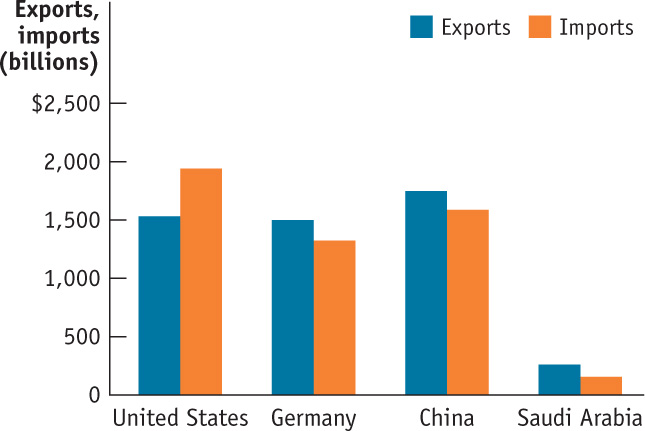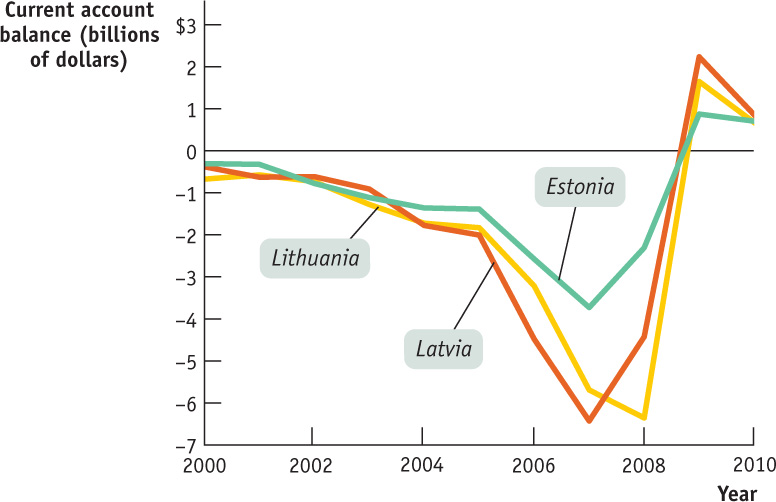International Imbalances
An open economy is an economy that trades goods and services with other countries.
A country runs a trade deficit when the value of goods and services bought from foreigners is more than the value of goods and services it sells to them. It runs a trade surplus when the value of goods and services bought from foreigners is less than the value of the goods and services it sells to them.
The United States is an open economy: an economy that trades goods and services with other countries. There have been times when that trade was more or less balanced—when the United States sold about as much to the rest of the world as it bought. But this isn’t one of those times.
In 2010, the United States ran a big trade deficit—that is, the value of the goods and services U.S. residents bought from the rest of the world was a lot larger than the value of the goods and services American producers sold to customers abroad. Meanwhile, some other countries were in the opposite position, selling much more to foreigners than they bought. Figure 10-9 shows the exports and imports of goods for several important economies in 2010. As you can see, the United States imported much more than it exported, but Germany, China, and Saudi Arabia did the reverse: they each ran a trade surplus. A country runs a trade surplus when the value of the goods and services it buys from the rest of the world is smaller than the value of the goods and services it sells abroad. Was America’s trade deficit a sign that something was wrong with our economy—that we weren’t able to make things that people in other countries wanted to buy?

No, not really. Trade deficits and their opposite, trade surpluses, are macroeconomic phenomena. They’re the result of situations in which the whole is very different from the sum of its parts. You might think that countries with highly productive workers or widely desired products and services to sell run trade surpluses but countries with unproductive workers or poor-quality products and services run deficits. But the reality is that there’s no simple relationship between the success of an economy and whether it runs trade surpluses or deficits.
322
Microeconomic analysis tells us why countries trade but not why they run trade surpluses or deficits. In Chapter 2 we learned that international trade is the result of comparative advantage: countries export goods they’re relatively good at producing and import goods they’re not as good at producing. That’s why the United States exports wheat and imports coffee. One important thing the concept of comparative advantage doesn’t explain, however, is why the value of a country’s imports is sometimes much larger than the value of its exports, or vice versa.
So what does determine whether a country runs a trade surplus or a trade deficit? In Chapter 19 we’ll learn the surprising answer: the determinants of the overall balance between exports and imports lie in decisions about savings and investment spending—spending on goods like machinery and factories that are in turn used to produce goods and services for consumers. Countries with high investment spending relative to savings run trade deficits; countries with low investment spending relative to savings run trade surpluses.
Baltic Balancing Act
The Soviet Union, once second only to the United States as a world power, broke up into 15 independent countries in 1991. Many of these countries have had a hard time finding a new place in the world, both politically and economically. However, the three small nations of Estonia, Latvia, and Lithuania—often referred to as the “Baltics” because they all have coastlines on the Baltic Sea—were quick both to establish democratic institutions and to move to market economies, building strong ties to the democratic market economies of Western Europe.
What has this meant for their international trade? Figure 10-10 shows the current account balances of the three countries—a broad definition of their trade balances—from 2000 to 2010. As you can see, in the middle years of that decade all three countries began running sizable deficits (amounting in each case to more than 10% of the total value of goods and services they produced.) Then, after 2008, all three suddenly moved into surplus.

323
Does this mean that these economies were doing badly around 2005 or 2006 and that they rapidly improved late in the decade? Actually, it was the opposite. During the period from 2000 to 2007, financial markets were extremely optimistic about the economic prospects of the Baltic nations and poured money into the countries, allowing them to engage in high rates of investment spending and, correspondingly, to run large trade deficits. When the world plunged into financial crisis, this inflow of funds dried up, forcing the Baltics to move into trade surplus. The adjustment was hard on the three countries, all of which saw unemployment rates rise to Depression-era levels.
Quick Review
- Comparative advantage can explain why an open economy exports some goods and services and imports others, but it can’t explain why a country imports more than it exports, or vice versa.
- Trade deficits and trade surpluses are macroeonomic phenomena, determined by decisions about investment spending and savings.
Check Your Understanding 10-5
- Which of the following reflect comparative advantage, and which reflect macroeconomic forces?
Question
iulK1mCFpRIPVBUwiKP8i2bbGbm57RKU6LatbXzF2lDCOPEl5lpejtQRK88gqKlMTMlEzsFYuwm7dghGAfbLt530a9LcVfSu4GkCAjI7F1li7t6YBJo7Df2H4f9TV1Pp74/DOZa9B36CNFVNUaiS+AX46QxLGcq5MsGrSMCEhtSrAHudW5degx93fHhuTa1T6L8JxomK2zZyQ1FWpxLxswoIwv2jcrlk/DouDCsZ+rFWi35ZQpWl9fGrgAwHX692taVv8DBBshHURrswdydR1+gZk3jpUgnadCKljADeQGWJpLrLq8RygJZzrvNDxXuFZ+vhXyL/3j1mulSIUpULLkKUb/LdRjdHvJtFU9Xfnz0rjIW2zbg+PNrMTKRLfAvljs7yj0JF2y8=This situation reflects comparative advantage. Canada's comparative advantage results from the discovery of oil. Canada now has an abundance of oil.Question
GGEWKII3/cbr+sArfHcYWgPDxiNnfaipwzyypamDnnkG8C4hjEKEbJatmCss0TsZeKpmUoD/n7YpHDO+hbQ1fK4BVXGKnAHXu414fnTTbAjDON8reSJunrQIxnA4Zkluok6C9eMQ4WnVarFhkjIFIWX0r6Tj/WoD4wc2ajh2OFF+UT18SbP0qdSi73EPI5BsEKnnkPbnsHYXimvKWlbqQEOmf4A2XH9phAPoQecbVrrnut4/LjOcdjAIJy+JqoHCRDUMNyvkoTw5ilHb0TqRCktZCJii6KI3EO/tK7FyA6x5+VcXIgvlZWqFmr1elSIIfqpp4UTQQcnixEsxCGQM9t9cbhdxKX6nnP0CzXXvkY89WbltE/lQyJKBhsGeKcPA1qbfJA==This situation reflects comparative advantage. China's comparative advantage results from an abundance of labor; China is good at laborintensive activities such as assembly.Question
dYdhFZRSFJocKgsRo7eyOcUsgM3DtG51IwlqenGPJmunKW/HFV+uWIg+K+Kt4JVxFFn8+fGvVL8sBEG4kCFrkz1SSipiqS42piz9Kz3GhTsnJffY4P/kIAReHKn2gPHfakx3Iy+31eeruc2gcxy1oZG5ImrbKVxDreWmYKzBpfAuS6rcm8yEkgOhpVvbwrGdQAGwhr6JgXReVGYRnwfJJNbz1VbaWNY//Z6h4heZyodSobJpodv1pHx8FnmqWSaXml8EEFJLlkzCrh5sv4lr5QbfJdv5XR+u3sVgF6CVb5FQzQpyCKd3Q935aPJRlYd8JQu561JDANKA0fT42amN3fwpD0c=This situation reflects macroeconomic forces. China has been running a huge trade surplus because of underlying decisions regarding savings and investment spending with its savings in excess of its investment spending.Question
InDAOSPMXkzBlqXA8ENso1cwF+4pKpisHSiqaZWjJ7+d+GiZcaYbwS1Dq51t3+JF/JIbgzGGKM6mOf92R/I4uY7+wxJ3NeN59apWJzTIibyMEb81CHRrjKdZqOL5ejRHE+wIPmrjDp9Zej7ABjj+Gpd7yxnShg/+rAz6+VSxv8uXEC+p6U/aWJJHg+zMYlsG9P1Yho+oRsHa4BNJjRH9Z9aIVPtO1C4Dc2J1CfZbqWbnp6wxA/QR7jq89+TUQIKTo77KSzrbK+/npY/efF7XjYSXpksnND2pBMn1ioEAzS9shtqmFKA/UfWpyagnT3Esbr0eRQDQKOUXGjyCCuafVngMTiAoDwTOEzCZfD5bXDtzpVvbgspaXCgzQY3PmiLALspVD8yqU2nm1BVsFCrk4q2yaqpvWA05FGid9KqrKUoJEXiEvBPUPw==This situation reflects macroeconomic forces. The United States was able to begin running a large trade deficit because the technology boom made the United States an attractive place to invest, with investment spending outstripping U.S. savings.
Solutions appear at back of book.